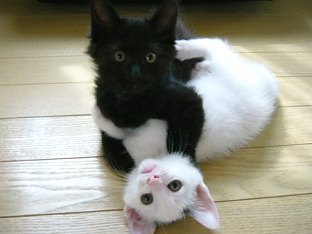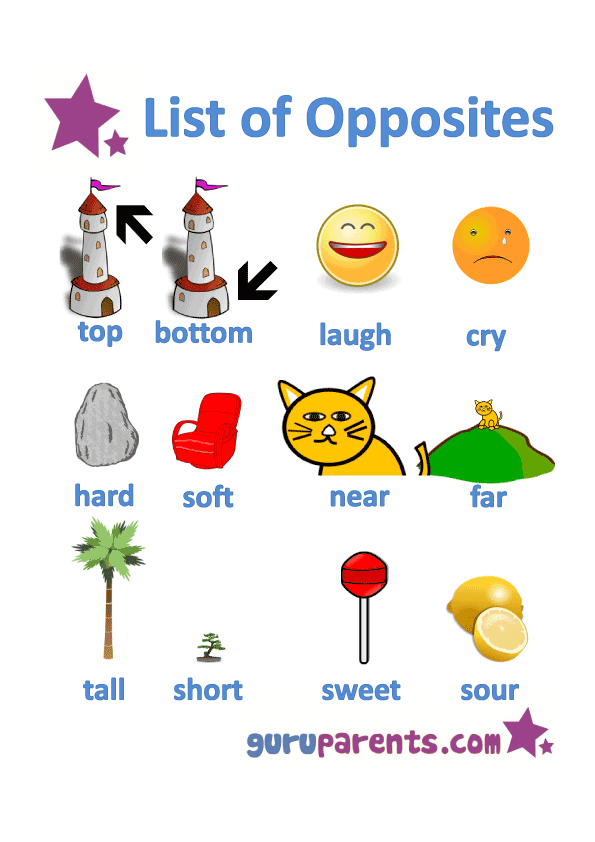Introducing Opposites at Circle Time
Introduce a theme on opposites at a group circle. Ask the children what they know about opposites. They will immediately begin giving examples. Pictures work well when describing opposites to children. There are many opposite posters available at teacher resource centers. Sometimes all it takes for better comprehension is to ask children for some opposites, such as "what is the opposite of day?"
Preschool Song for an Opposite Theme
To the tune of Do You Know the Muffin Man:
Opposites, oh opposites
We know them,
We know them,
Opposites, oh opposites
I think that we know them
The opposite of black is _____ (let the children answer)
Black and white
Black and white
The opposite of black is white
We know our opposites
Continue the song with different opposites, here are some suggestions for this age group:
•boy and girl
•day and night
•full and empty
•big and small
•soft and hard
•hot and cold
1) Opposite Pictures: The young children will be required to cut out the individual pictures and then paste them another sheet of paper with proper pairing. The blank sheet should have squares drawn on it to aid the preschoolers on where to place the pictures, with some opposite pairs already done to provide visual guidance. This craft is developmentally appropriate for four year olds and older.
2) Jars Empty and Full: A great craft for younger ages is to provide children with a sheet displaying two big jars or containers. Give the children bingo markers and explain that they have to fill up one jar and leave the other one empty. This craft activity could be completed with other material, instead of a bingo marker, such as sand art (glue with sand), shredded paper, pom poms, and so forth.
3) Hot and Cold Pictures: find pictures in magazines or symbols, such as stickers or foam pieces, representing hot and cold weather. The children must decide which paper to place their item on, the one with a sun showing or the one with snowflakes showing. This project could be changed according to the age group. If it is older preschool ages, then have the words hot and cold printed onto the paper as well and perhaps have them draw and decorate their hot and cold papers first before gluing the collage pieces on.
Preschool Games for an Opposite Theme
1. Transition children out of a circle time by giving each child a small toy, and then give directions to help teach the opposite concept. Tell a child, "Before you leave circle, please take this toy and place in on top of your head, and now place it on the bottom of your shoe". Some other directions could be:
•on and off
•in front, and in the back
•over and under
•forward and backward
2. Choose an opposite pair and place items into a bag for children to pick out and then place into the right group. The two spots to place the items to will be in the middle of the circle and be established by the teacher. So, for instance, if you chose day and night, then place into the bag such items as pjs, stars, sunglasses, something used at preschool, moon, flashlight, sun, sleeping bag, suntan lotion and more.
3. Another game to play is the shoe game. Begin by telling the children to take one shoe OFF and keep one shoe ON and then ask the children if there was an opposite in the sentence just said. All the children will place one shoe into the middle of the circle, and one child at a time will be asked to leave the room or close his/her eyes. A shoe will be removed (or the child whose shoe it is will hide) and the selected child will have to guess whose shoe is missing.
Fun Theme Days for Opposite Preschool Lesson Plan
Within the length of the opposite lesson, plan to have some fun theme days.
1. Pyjama and Teddy Bear Day. (DAY-NIGHT)
2. During the winter months, try having a beach party inside. (WINTER-SUMMER)
3. Opposite Dress Up Day. Some ideas are:
•backward clothes
•one sided hairstyles
•black and white clothes
•day and night clothes
•clothes for hot and cold weather
4. Opposite Oder: have parts of the preschool schedule done in an opposite order, such as the good bye song sung first and the welcome song sung last.
 |
| Opposite Preschool Theme |
Suggested Books about Opposites
There are many book on opposites. There are some classic stories that have opposites riddled throughout the pages, such as The Three Little Bears. Here are a handful of other suggestions:
•Opposites by Sandra Boynton (Little Simon, 1982)
•Foot Book by Dr. Seuss (Random House, 1996)
•Olivia's Opposites by Ian Falconer (Atheneum, 2002)
Opposites is a really fun topic to discuss with young children. The theme days allow children some silly moments of doing something out of the ordinary. Hopefully this article will trigger ideas for more opposite activities within your preschool curriculum and/or early childhood setting.






)



















